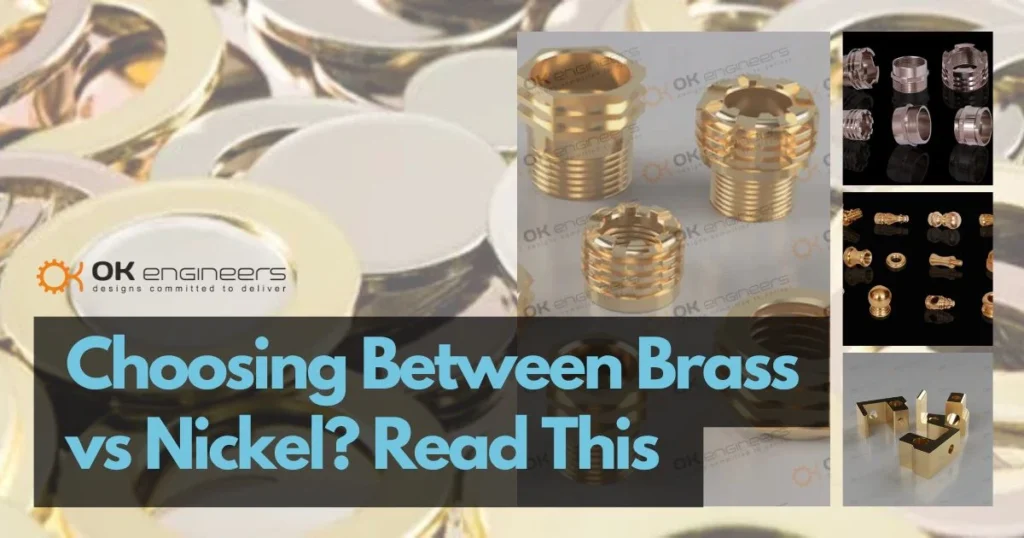Introduction: Why Choosing the Right Material Matters
Choosing the right material between Brass vs Nickel components can make or break your project. Whether you’re in manufacturing, design, or maintenance, the decision between brass and nickel is crucial. OK Engineers understands this dilemma and brings you an expert guide on the topic. This article will help you make an informed choice by covering the properties, advantages, trends, and practical insights you need before deciding on brass or nickel components. Avoid regret by reading this detailed comparison, geared for clarity and ease of understanding.
Brass vs Nickel: What Are They?
Brass is an alloy primarily made of copper and zinc, known for its warmth, durability, and corrosion resistance. Nickel, on the other hand, is a versatile metal often used as a coating or alloying element to improve strength, rust resistance, and finish in various industrial and decorative applications.
Key Differences Between Brass vs Nickel
| Brass vs Nickel: Feature Comparison | Description |
| Composition | Brass: Copper + Zinc; Nickel: Pure metal or alloy |
| Color | Brass: Yellowish, warm tone; Nickel: Silvery-white |
| Corrosion Resistance | Brass: Good; Nickel: Excellent |
| Durability | Brass: Strong but softer; Nickel: Very durable |
| Cost | Brass: Lower cost; Nickel: Higher cost |
| Applications | Brass: Decorative, plumbing; Nickel: Coatings, aerospace |
Advantages of Brass Components
- Cost-Effective: Brass is usually cheaper than nickel, making it suitable for large-scale industrial uses without compromising quality.
- Machinability: It’s easier to work with brass for shaping and casting, saving manufacturing time.
- Resistance to Corrosion: Brass offers good protection against water corrosion, ideal for plumbing and marine uses.
- Aesthetic Appeal: Its warm, golden color is often preferred for decorative hardware and musical instruments.
Advantages of Nickel Components
- Superior Corrosion Resistance: Nickel thrives in harsh chemical and industrial environments.
- High Durability: Nickel-coated components last longer and withstand wear better.
- Versatility: Used extensively for plating other metals to enhance surface properties.
- Modern Demand: Increasingly popular in battery and electric vehicle industries due to its metal-ion properties.
How to Choose Between Brass vs Nickel
When selecting between brass and nickel for your next project, consider:
- Application environment: Use nickel in chemically aggressive or high-wear settings; brass works well in decorative or moderate corrosion contexts.
- Budget constraints: Brass is budget-friendly for large volume needs.
- Aesthetic requirements: Choose brass for a warmer look and nickel for a sleek, modern silver finish.
- Longevity: Nickel often guarantees longer lifespan but at a higher price.
You May Also Like This: Top 10 Stainless Steel Components
Comparison Tables: Brass vs Nickel Properties, Uses, and Cost
Table 1: Brass vs Nickel Physical Properties
| Brass vs Nickel: Physical Properties | Brass | Nickel |
| Density | 8.4–8.7 g/cm³ | 8.9 g/cm³ |
| Melting Point | 900–940 °C | 1455 °C |
| Tensile Strength | 300–600 MPa | 550–900 MPa |
| Electrical Conductivity | Moderate | Low |
Table 2: Brass and Nickel Common Uses
| Brass vs Nickel: Common Uses | Brass | Nickel |
| Plumbing | Pipes, fittings | Coating on stainless steel |
| Musical Instruments | Trumpets, trombones | Plating on sound hardware |
| Decorative Hardware | Door handles, locks | Aerospace and batteries |
| Industrial Parts | Bearings, valves | Electroplating, batteries |
Table 3: Brass and Nickel Cost Comparison
| Brass vs Nickel: Approximate Cost (per kg) | Material | Cost Range |
| Brass vs Nickel | Brass | $3–$6 |
| Brass vs Nickel | Nickel | $15–$20 |
Trends and Market Insights 2025
The nickel market in 2025 reflects an increasing surplus driven by demand growth in electric vehicle batteries and industrial applications, despite recent price dips averaging around $15,000 per metric ton. Brass remains popular due to its cost efficiency and rich history in manufacturing. Trends suggest nickel prices may rise later as demand overtakes supply by 2030. OK Engineers keeps a close eye on these dynamics to help clients choose the most suitable material now and for future-proofing projects.
FAQs: Brass vs Nickel Components
Q1. Which is better for corrosion resistance, brass or nickel?
Ans. Nickel provides superior corrosion resistance, particularly in harsh environments, while brass is good for moderate moisture conditions.
Q2. Can brass be plated with nickel?
Ans. Yes, nickel plating on brass is common to combine the aesthetic of nickel with the machinability of brass.
Q3. Is nickel more expensive than brass?
Ans. Yes, nickel typically costs significantly more due to mining and processing challenges.
Q4. Which material lasts longer?
Ans. Nickel components generally have a longer lifespan due to higher hardness and corrosion resistance.
Q5. Are these metals recyclable?
Ans. Both brass and nickel are recyclable, making them environmentally friendly choices in manufacturing.
Conclusion
Choosing between brass and nickel depends on your specific needs, including durability, corrosion resistance, cost, and aesthetics. Brass offers affordability and ease of use, suitable for decorative and plumbing applications. Nickel excels in harsh environments with its outstanding durability and corrosion resistance, though it comes at a higher price. For balanced decisions, consider your project’s environment and budget. OK Engineers is your go-to resource to guide this choice with expertise and market insight. Armed with this knowledge, you can confidently select the right components that won’t lead to regret.



